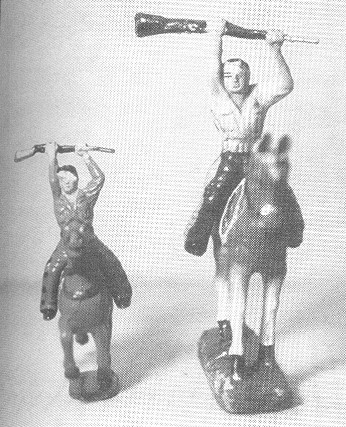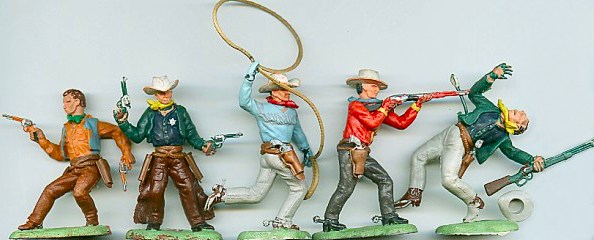TIMPO's positioning on the toy market
The figure types - their production way - the selling strategy: TIMPOs ingenious mix
Alfred Plath compiled some biographic material concerning the firm founders of Toys Importers Ltd. in his book. Salomon Gawrylovitz had already worked as an agent for play goods companies, when he still lived in Germany. Escaping from the national socialists he decided England to become his place of residence. There he took over the name Ally Gee. Thus he was exile-German. One can speculate upon the fact that he surely had brought along some conceptions over play goods from Germany. For example Warren K. Mitchell compares in the book of Richard O'Brian the early TIMPO figures made of metal with the older mass figures made by the German producer Elastolin. One recognizes clearly in the TIMPO figure a copy of the Model of Elastolin. It is interesting to pursue this thoughts further on: TIMPO developed the idea of a cowboy figure striking a rifle over the head to a cash racquet. The figure was invented in Germany in the thirties, was copied in metal in England during the fifties and in the seventies in plastic. The figure experiences world-wide spreading as a swoppet. Elastolin figures are still the large competitors of TIMPO figures between collectors today.

on the left the TIMPO figure, on the right the Elastolin model
One can confidently call the company Britains as a second competitor of TIMPO. Approximately a third of all play figure types are Britains figures. William Britains already had begun the production of figures in the size of 54 mm in the 19th century. Therefore this figure size is often also designated as Britains size. The hollow casting procedure had been developed by William Britains in order to save material and weight. The principle of a swoppet figure also is a development made by the Britains company: the manufacturer Herald (in former times Zang) was bought up by Britains. Herald had invented the swoppet figures first. TIMPO took over all three technical innovations Britains made. James Opie reports that TIMPO had the goal to be called second beside Britains concerning the quality of the figures in the center of the fifties. Children seem not to be interested in such a way, because realism in shaping and painting is only one of the reasons for a child to find a figure desire-worth for playing with. The company Britains sold its figures in exclusive stores like Harrods, they weren't ubiquitous, but TIMPO's were ...

those first of all Swoppets of 1958, not
made by TIMPO,
but by Herald, a company bought up by Britains
a Barclay girl , a pretty Dimestore figure